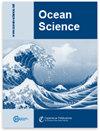以绝对盐度、恒温和原位压力表示的海水热力学潜力
IF 3.3
3区 地球科学
Q2 METEOROLOGY & ATMOSPHERIC SCIENCES
引用次数: 0
摘要
摘要。导出了海水作为保守温度、绝对盐度和压力的函数的热力学势。从这个热力学势可以找到海水的所有平衡热力学性质,正如所有这些热力学性质都可以从TEOS-10(国际海水热力学方程- 2010;IOC等人,2010)Gibbs函数(这是原位温度、绝对盐度和压力的函数)。目前在吉布斯海水海洋学工具箱中,海洋学实践使用一个多项式表达式来表示守恒温度(以及绝对盐度和压力)的比容(和焓),而原位温度和守恒温度之间的关系是基于吉布斯函数的。这种混合实践引入了变量之间的不一致性和多余的转换(数值很小)。所提出的海水热力学势,被表示为保守温度的显式函数,克服了这些小的数值不一致,此外,新方法在从保守温度评估海面温度时允许更高的计算效率。当使用保守温度时,焓的热力学信息与熵的热力学信息是独立的。这与使用原位温度或势温的情况形成对比。在这些情况下,单一热力学势的重要目的是避免在焓和熵的函数形式之间强加单独的一致性要求。本文章由计算机程序翻译,如有差异,请以英文原文为准。
A thermodynamic potential of seawater in terms of Absolute Salinity, Conservative Temperature, and in situ pressure
Abstract. A thermodynamic potential is derived for seawater as a function of Conservative Temperature, Absolute Salinity and pressure. From this thermodynamic potential, all the equilibrium thermodynamic properties of seawater can be found, just as all these thermodynamic properties can be found from the TEOS-10 (the International Thermodynamic Equation of Seawater – 2010; IOC et al., 2010) Gibbs function (which is a function of in situ temperature, Absolute Salinity, and pressure). Present oceanographic practice in the Gibbs SeaWater Oceanographic Toolbox uses a polynomial expression for specific volume (and enthalpy) in terms of Conservative Temperature (as well as of Absolute Salinity and pressure), whereas the relationship between in situ temperature and Conservative Temperature is based on the Gibbs function. This mixed practice introduces (numerically small) inconsistencies and superfluous conversions between variables. The proposed thermodynamic potential of seawater, being expressed as an explicit function of Conservative Temperature, overcomes these small numerical inconsistencies, and in addition, the new approach allows for greater computational efficiency in the evaluation of sea surface temperature from Conservative Temperature. It is also shown that when using Conservative Temperature, the thermodynamic information in enthalpy is independent of that contained in entropy. This contrasts with the cases where either in situ temperature or potential temperature is used. In these cases, a single thermodynamic potential serves the important purpose of avoiding having to impose a separate consistency requirement between the functional forms of enthalpy and entropy.
求助全文
通过发布文献求助,成功后即可免费获取论文全文。
去求助
来源期刊

Ocean Science
地学-海洋学
CiteScore
5.90
自引率
6.20%
发文量
78
审稿时长
6-12 weeks
期刊介绍:
Ocean Science (OS) is a not-for-profit international open-access scientific journal dedicated to the publication and discussion of research articles, short communications, and review papers on all aspects of ocean science: experimental, theoretical, and laboratory. The primary objective is to publish a very high-quality scientific journal with free Internet-based access for researchers and other interested people throughout the world.
Electronic submission of articles is used to keep publication costs to a minimum. The costs will be covered by a moderate per-page charge paid by the authors. The peer-review process also makes use of the Internet. It includes an 8-week online discussion period with the original submitted manuscript and all comments. If accepted, the final revised paper will be published online.
Ocean Science covers the following fields: ocean physics (i.e. ocean structure, circulation, tides, and internal waves); ocean chemistry; biological oceanography; air–sea interactions; ocean models – physical, chemical, biological, and biochemical; coastal and shelf edge processes; paleooceanography.
 求助内容:
求助内容: 应助结果提醒方式:
应助结果提醒方式:


